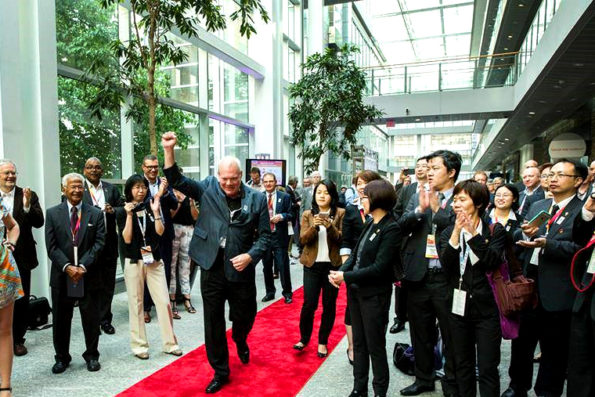To be the pre-eminent organization in Canada that encourages cities and societies of all sizes and different cultures from across Canada to become better, caring and economically successful communities.
ABOUT US
Intelligent Community Forum Canada
VISION
HISTORY
The Intelligent Community Forum (ICF), headquartered in New York City, is a worldwide organization that is renowned for its efforts recognizing Intelligent Community excellence through its research, publications, annual awards programs, workshops, conferences, site visits and other support. Today there are nearly 200 Intelligent Communities around the world, and growing annually, with Intelligent Community representatives on every continent. The Intelligent Community Forum Foundation (ICFF) is the association of these Intelligent Communities, aimed at working together to share information and develop more Intelligent Communities throughout the world. As ICF’s unique methodology is sought after around the world, there is an opportunity for each country to focus its ICF-related efforts within their region. In Canada, we currently have 46 cities, towns and regions recognized officially as Intelligent Communities by ICF. ICF Canada is ICF’s official national non-profit organization that supports ICF’s goals and programs in Canada. To learn more or to apply for its awards, secure an Analyst’s Report, develop an Accelerator, become a member or any other support, contact Matt Owen at [email protected] .
Learn More
ICF Canada is the first global representative office of its kind outside of ICF’s global headquarters. The purpose of ICF Canada is to promote the development of the Intelligent Community movement within Canada and by example, promote the goals of creating the best cities and educated workforce possible around the world through the criteria established by ICF. As a result, ICF Canada is positioned to respond to requests by Canadian communities of all sizes across the nation about the criteria, awards, conferences, workshops and any other activities of ICF and ICFF as well as work with its partners, ICF Institutes and intermediaries in Canada and around the world in their effort to help create the best communities possible for its citizens and for the country as a whole.
As a direct link to creating better cities, is the goal of attracting and retaining talent as well as attracting and retaining investment, especially Foreign Direct Investment (FDI). As such, ICF Canada is an educator, an advocate as well as an agent to assist its ICF Canada members to position its Smart City and Intelligent Communities as locations of choice and for global participants to benefit from the brand of being recognized as a Smart21 community or as an Intelligent Community.
PRINCIPLES

Broadband Infrastructure
Focus on Infrastructure, especially use and application of high speed broadband, which is the next essential utility, as vital to economic growth as clean water, highways and electricity. As the Internet of Things is upon our doorstep, it connects your computer, smart phone and other smart devices to billions of devices and users around the world, creating a digital overlay to our physical world that is revolutionizing how we work, play, live, educate and entertain ourselves, govern our citizens and relate to the world. It must however be accessible and affordable for all our citizens to use and benefit from. Robust and affordable broadband and excellent logistics capabilities are key attractors of FDI (investors) and talent to communities.
Broadband and Information Technology
Canadian Intelligent Communities have been successful at in attracting investment in broadband networks from a mix of private-sector, Federal and Provincial sources as well as from within their own budgets. In 2012, the last year for which statistics are available, residential broadband availability in Canada was 97% on a national level, 100% in urban areas and 85% in rural ones. The average reported by the Canadian Intelligent Communities was 98% for both urban and rural communities. Forty-seven percent of the Intelligent Communities reported offering 100% residential availability.
According to the CRTC, average broadband adoption in Canada was 77% in 2012. Average adoption across the Intelligent Communities reporting in 2015 was 85%. The CRTC also reported that, as of 2012, only 35% of Canadian households had access to broadband speeds of 100 Mbps or greater. By contrast, 93% of the Intelligent Communities provided speeds in excess of 100 Mbps, and 60% offered speeds in the gigabit range. The broadband offerings in Canadian Intelligent Communities are also cost-effective. Of the communities submitting data, 75% have an average cost per megabit per month of $2 or less.
Impacts on the Community’s Competitiveness
The report provides descriptions of the strategies and programs through which Canada’s Intelligent Communities create and deploy broadband assets. Communities covered include:
- Hamilton, Ontario
- Montreal, Quebec
- Moncton, New Brunswick
- Stratford, Ontario
- Sarnia-Lambton County, Ontario
- Sherbrooke, Quebec
- Toronto, Ontario
- Winnipeg, Manitoba
Knowledge Workforce
Focus on Building a Knowledge Workforce, attracting Talent and retaining that Talent is essential for our successful communities. Today, all desirable jobs in industrialized economies – and increasingly in developing economies as well – require a higher component of knowledge than they did in the past. It is by applying knowledge and specialized skills that employees add enough value to what they do to justify the cost of employing them. In the future, any employee whose “value-added“ does not exceed his or her salary cost can expect to be replaced, sooner or later, by software or hardware. A continuous improvement in an evolving range of skills is the only route to personal prosperity. That talent is highly sought after and will attract investors to capture the talent capital in the community. This is a huge opportunity for communities seeking to attract and retain FDI.
The key to turning the broadband asset into economic impact is a highly skilled workforce. Employment at every level of the economy demands greater knowledge and skills today than it did a decade ago. Investments in improving the skills of the workforce pay off in higher rates of employment, higher household incomes and stronger economic growth. They also raise the potential return on investment in the assets and organizations within the community, the province and the nation.
Achievements and Challenges
The Canadian Intelligent Communities demonstrate a range of educational attainment. In the top seven communities – Waterloo, Calgary, Ottawa, Stratford, Toronto and Montreal – more than 35% of the population has attained either an undergraduate or graduate degree. The Canadian national average in 2012 was 22% having at least an undergraduate degree. Of the remaining 9 communities on the list, seven have a higher percentage of their population whose highest educational attainment is a community college or technical school certificate, ranging from 42% in Western Valley to 19% in Hamilton. These also represent skilled labor and reflect a population trained for industrial, healthcare, operations, skilled trade and related occupations.
Technology in Schools
Across the Canadian Intelligent Communities, there is a strong recognition of the vital importance of technology in their economic futures. The overwhelming majority have FOR Sharpening Canada’s Competitive Advantage Page 6 of 138 invested in technology for elementary through high school students, from giving schools an interactive online presence to integrating ICT in classroom instruction, distance learning and specialized classes in ICT and entrepreneurship skills.
Connecting School to Work
There is an equally strong commitment to creating an “on-ramp” from education to employment. Of the Intelligent Communities in the sample, 100% produce careers fairs and employer open house events, as well as internship and work-study programs. More than 80% report that their educational institutions work with employers to develop customized skills training programs, and 75% maintain formal education-employer task forces to provide leadership and continuity.
How Communities Build a Knowledge Workforce
The report provides descriptions of community strategies to equip their young residents with economically competitive skills and create close engagement between educators and employers. Communities covered include:
- Burlington, Ontario
- Hamilton, Ontario
- Montreal, Quebec
- Ottawa, Ontario
- Sherbrooke, Quebec
- Stratford, Ontario
- Toronto, Ontario
Innovation and Creativity
Innovation and creativity are the keys to successful communities. They are essential to the interconnected economy of the 21st Century. Intelligent Communities pursue innovation through a relationship among business, government and such institutions as universities, hospitals and non-profits/NGOs. This Innovation Triangle or “Triple Helix” helps keep the economic benefits of innovation at the local level, and creates an innovation ecosystem that engages the entire community in positive change. Investments in innovative technology by government contribute to that culture and improve service to citizens while reducing operating costs. Communities that endeavor to be collaborative innovation ecosystems are at the top of the game in attracting and retaining talent and investors in a successful community. Innovative firms are able to commercialize creative products, services and solutions using local and attracted investment and talent. “Start-up” facilities are formed with home-grown businesses in a variety of tech enabled sectors and the buzz of success attracts further investors and talent as a result.
Innovation is essential to the interconnected economy of the 21st Century. Intelligent Communities pursue innovation through a relationship between business, government and such institutions as universities and hospitals. The Innovation Triangle or “Triple Helix” helps keep the economic benefits of innovation local, and creates an innovation ecosystem that engages the entire community in positive change. Investments in innovative technology by government contribute to that culture and improve service to citizens while reducing operating costs.
Innovation Ecosystems
The Canadian Intelligent Communities share a strong commitment to developing these innovation ecosystems, seeing them as essential to increasing the value of their economic output and creating inclusive prosperity in an age of disruption. Most have assembled public and private-sector investment in innovation hubs, from incubators and accelerators to makerspaces.
The communities promote a broad range of public-sector and private-sector innovation programs. All of the communities reporting on their programs have makerspaces, business incubators and business accelerators, as well as offering entrepreneurship mentoring and training and an array of hackathons, mashups and business plan or technology contests. The availability of venture capital and angel investment, which fuels company growth, is also widespread, according to the communities.
The average for urban areas in Canada was 0.5 incubators and accelerators per 100,000 people in 2011. The average for the Canadian Intelligent Communities was 1.43 incubators and accelerators per 100,000 people. Adding makerspaces to the total yields an average of 2.71 innovation spaces per 100,000 people. Smaller and more rural communities are equally likely to lead in programs that promote local innovation and entrepreneurship.
Start-Ups
The goal of these innovation hubs is to accelerate the community’s ability to generate startup companies with the potential for fast growth and significant job creation. The Canadian Intelligent Communities reported an average of 150 start-ups per 100,000 of population, with a high of 649 and a low of 7. Comparable statistics for Canada are hard to come by. Start Up Canada estimated, based on Stats Canada information, that there were 104,000 new small businesses created in Canada from 2002 to 2007. As of December 2012, there were nearly 1.2 million small businesses in Canada with at least one employee on the payroll.
Public-Sector Services
The public sector contributes to the innovation ecosystem by providing digital services that help make their communities attractive to innovative individuals and companies, as shown by the chart below. Web and mobile services are universal, and the majority of communities are involved in open data, smart meter and online business service projects as well.
Job Creation
What is the impact of all this activity on the most important indicator of all: job creation? The majority of Canadian Intelligent Communities have been effective creators of employment opportunity, which averaged a job-creation rate of 60 per 1,000 in the labour force. Those appearing to struggle most with job creation are working to overcome legacy industrial job loss and the barriers of distance from other population centers.
Constructing the Innovation
Triangle The report describes how individual communities are actively constructing Innovation Triangle ecosystems to create a new generation of entrepreneurial employers. Communities covered include:
- Burlington, Ontario
- Hamilton, Ontario
- Moncton, New Brunswick
- Montreal, Quebec
- Ottawa, Ontario
- Sarnia-Lambton County, Ontario
- Sherbrooke, Quebec
- Stratford, Ontario
- Toronto, Ontario
- Waterloo, Ontario
- Winnipeg, Manitoba
Digital Equality
Digital Equality is an essential principle of a caring, inclusive and healthy Intelligent Community, namely, everyone in the community deserves access to broadband technologies and the skills to use them. Like most principles, it is easier to understand than it is to execute on a daily basis. But the explosive advance of the broadband economy has worsened the exclusion of people who already play a peripheral role in the economy and society, whether due to poverty, lack of education, prejudice, age, disability, or simply where they live. It has disrupted industries and whole sectors from manufacturing to retail services, enlarging the number of people for whom the digital revolution is a burden rather than a blessing. Building a bridge to help these citizens gain a foothold on a life that is rewarding and allowing them to gain respect and prosperity is also a sign of a mature and caring community that further attracts investors and inspires collaboration.As broadband deploys widely through a community, there is serious risk that it will worsen the exclusion of people who already play a peripheral role in the economy and society, whether due to poverty, lack of skills, prejudice or geography. Intelligent Communities promote digital equity by creating policies and funding programs that provide everyone with access to digital technology and broadband, by providing skills training and by promoting a compelling vision of the benefits that the broadband economy can bring to their lives.Access to Technology
The Canadian Intelligent Communities invest in a broad range of digital equity programs for its citizens. The two most common are the provision of computers with free broadband access, typically at public libraries, and the creation of Wi-Fi hotspots at libraries, municipal facilities and public spaces.Improving Digital Skills
Ninety-four percent of the communities surveyed provide free digital skills training classes, typically through the library networks, and 70% supplement that with free tech support advice. Slightly over half have formal programs that identify potential community champions for digital equity and provide them with training and support. The same percentage operate computer donation programs that bring IT and connectivity to low income households. Many Intelligent Communities also focus on raising the digital skill level of employers, particularly the small-to-midsize companies that employ the vast majority of citizens but that also tend to lag bigger companies in technology adoption. Seventy percent offer digital skills training classes to their business sectors, and 65% take the next step by bringing together educators and business people to craft custom training courses for employees.Levelling the Digital Playing Field
The report explores the holistic approach taken by individual communities to overcoming the barriers that cause exclusion.
- Communities covered include:
- Burlington, Ontario
- Hamilton, Ontario
- Moncton, New Brunswick
- Montreal, Quebec
- Sarnia-Lambton County, Ontario
- Sherbrooke, Quebec
- Stratford, Ontario
- Winnipeg, Manitoba
Sustainability
Sustainability is a new principle and indicator of ICF’s Intelligent Communities. Improving current living standards, while maintaining the ability of future generations to do the same, is at the core of sustainability. Throughout human history, social and economic growth has always involved the consumption of more resources and the production of more waste. As humanity begins to push up against the limits of the ecosystem, we need to find ways to continue growth – with all of its positive impacts on the community – while reducing the environmental impact of that growth. ICF is committed to seeking to develop net zero energy communities as part of its criteria as Intelligent Communities. Environmental sustainability has become a global imperative, as the world comes to grips with the reality of climate change driven by our industrial lifestyles. At the local level, a commitment to greater sustainability provides multiple positive impacts. Communities that use fewer resources to create products and provide services are more efficient and productive, which is key to continued improvements in standard of living. Most sustainability measures also have a visible impact on local quality of life, from cleaner air and water to improved public transportation and greater “livability”. For all of these reasons, a long-term commitment to sustainability tends to attract inward investment and helps create a quality of life that attracts and retains talent. The Intelligent Community Forum assesses sustainability based on a specific set of environmental statistics. These include:
- Air quality
- Per-capita indoor water use, residential and commercial
- Per-capita tonnage of municipal waste directed to landfills after diversion for recycling and composting
- Percentage of total trips made without driving a car
- Degree of support from municipal leadership for the sustainability agenda
- The per-capita amount of green space
By these metrics, the Canadian Intelligent Communities score extremely well in terms of environmental sustainability. On ICF’s scale of 1-5, in which 5 is the high score, the current global average of communities is 3.76. Nine of the eleven reporting Communities in the sample scored above this average, with 82% scoring 4 or better.
Citizen Engagement
Citizen engagement through good governance and public advocacy are key to ensuring that the community transforms itself in the way that benefits everyone and sets the right pathway to long-term success. The willingness to embrace change and the determination to help shape it are core competencies of an Intelligent Community. Few places naturally possess those competencies. They must be cultivated, often over years, through advocacy and require excellent leadership and collaboration among community members to make it happen. Establishing a brand that results from excellent marketing, advocacy and citizen acceptance and engagement as an “Intelligent Community” often helps to differentiate these communities from others and benefits them from an economic development and social ecosystem perspective. This further reinforces these communities as highly collaborative, innovative and desirable communities in which to invest in, be part of and from which others are inspired to emulate.
It is all too common for a community’s leaders or groups of citizens to set themselves against changes that would ultimately benefit the community. The willingness to embrace change and the determination to help shape it, however, are core competencies of the Intelligent Community. Few places naturally possess those competencies. They must be cultivated, often over years, through advocacy. Advocacy is the ability to engage those leaders and citizens, as well as businesses and institutions, in understanding the challenges, identifying opportunities for positive change and ultimately becoming champions of that change. Advocacy is the energy that powers every other element of the Intelligent Community. It is in some ways the most complex and challenging aspects of community development, but it is essential. In a representative government, if people do not understand the challenges they face and the need to adapt to those challenges, they will stand in the way of action. But if they embrace a vision of positive change, nothing can stop them.
Engagement
The Intelligent Communities use all of the tools of advocacy to engage citizens and stakeholders, as well as their political leadership, in understanding and promoting positive change. Every community in the sample is an active user of social and streaming media to reach citizens online, as well as conducting frequent open government meetings and smaller meetings and surveys with project or interest groups. Ninety-four percent have advanced to the publication of formal strategies and issuing public progress reports on their success, while a further 82% have appointed a citizen task force to oversee progress.
External Communication
The communications efforts of the Intelligent Communities are not just focused inward. In a globally connected and competitive world, the communities in our sample show themselves to be active marketers of the economic opportunities they can offer, using every means available. Online and social media marketing is universal. Nine out of every ten communities attend targeted trade shows and participate in third-party trade missions and development projects. Eighty-two percent welcome in-bound delegations from cities and business groups and employ professional lead generators, and slightly fewer pay for public relations and advertising programs.
Advocating for their Communities
Canada’s Intelligent Communities pursue advocacy in its broadest sense, as described in detail in the report. Communities covered include:
- Hamilton, Ontario
- Montreal, Quebec
- Sarnia-Lambton County, Ontario
- Winnipeg, Manitoba








